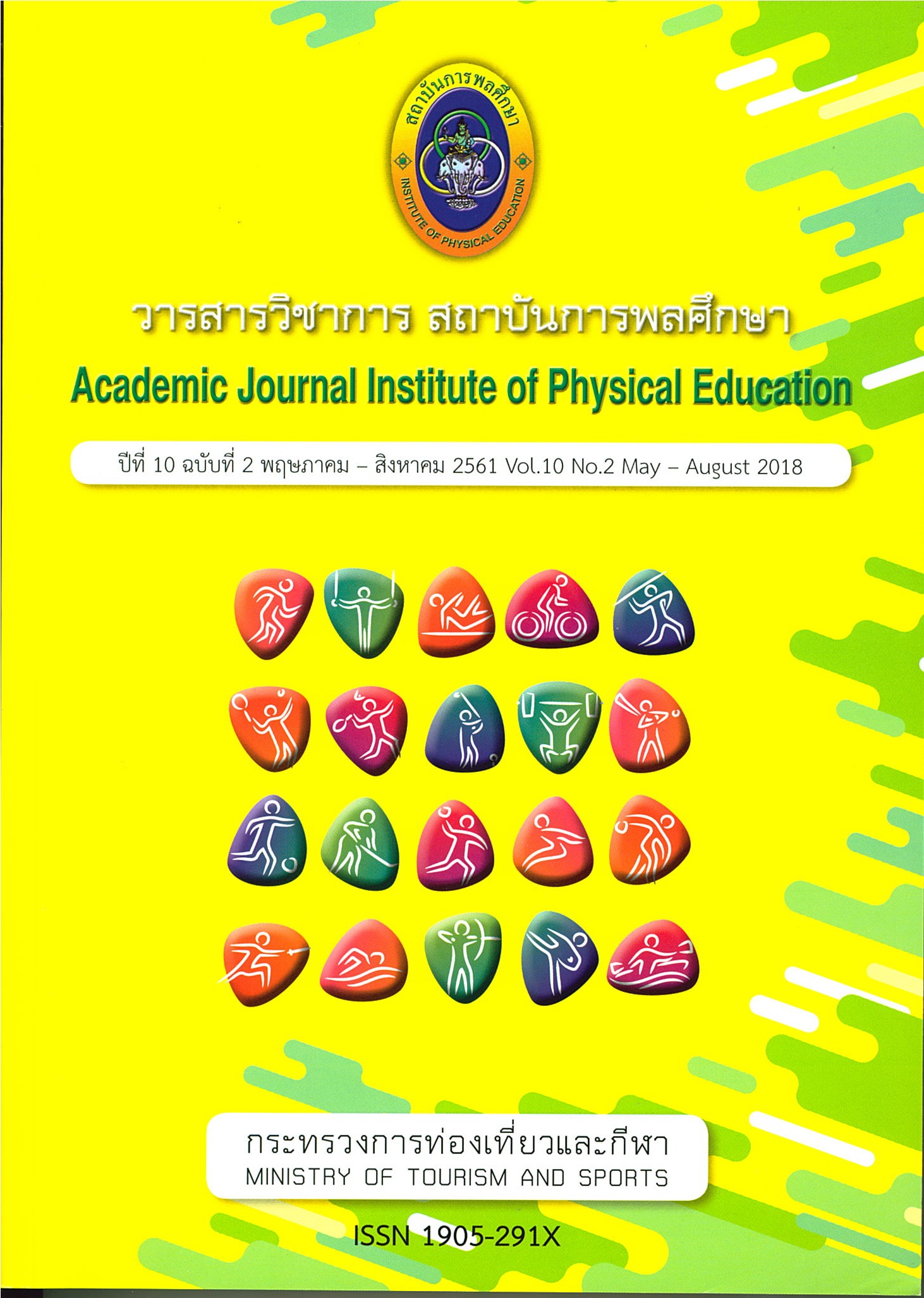Development and Evaluation of Dancesport Digital Media for Healthy
Main Article Content
Abstract
The research’s objective is to assess opinions on the use of digital media in dancesport for health and to study the development of digital media in dancesport by comparing the levels of knowledge, perception, and skills.The Sampling for the study were 30 students in the Faculty of Sports Science and Health, Institute of Physical Education Sukhothai Campus. Research tools consist of digital media on dancesport for health, a questionnaire, a knowledge test, anattitudee valuation form, and a dancesport skill evaluation form. Data were analyzed by means, standard deviation, and paired sample t-test.
The results were as follows.
1. The results revealed that the digital media on dancesport for health consists of two parts. Firstly, a digital video was produced with Sony Vegas Pro software, and uploaded to the internet on YouTube. Secondly, an e-book was made using Flip PDF Professional software, and published on WordPress. The assessment of opinions on the use of digital media on dancesport found that the design, layout, and content were highly appropriate.
2. The comparison of knowledge, attitude, and dancing skills, before and after the use digital mediaon dancesport for health were different witha significance levelof .05. In conclusion, the results showed that digital media is appropriate for dancesport for health, and 30 minutes of using digital media on dancesport for health four times a week for six weeks is able to develop students’ knowledge, perception, and dancesport skills.
Article Details
The published article is a copyright of the Academic Journal of Thailand National Sports University. The passage appeared in each article in this academic journal is a perspective of each author which is not related to the journal. Each author is required to be responsible for all components of his/her own article. If there are any mistakes, each author must be responsible for those mistakes on his/her own.
References
จันทิมา ฤกษ์เลื่อนฤทธิ์, พรปวีณ์ ชื่นใจเรือง,จิรวรรณ อินคุ้ม, ดวงเดือน รัตนะมงคลกุล,อริสรา สุขวัจนี และเพชรัตน์ รุจิพงศ์. (2557). ผลของการใช้สื่อการสอนออนไลน์และแผนที่ความคิดต่อทัศนคติความสุขและระดับความรู้ในการเรียนวิชาการพยาบาลผู้ใหญ่ของนิสิตพยาบาลมหาวิทยาลัยศรีนครินทรวิโรฒ. วารสารคณะพลศึกษา.17(1).183-195.
ธงชัย เจริญทรัพย์มณี. (2542). การลีลาศ: กีฬาเพื่อสุขภาพ. กรุงเทพฯ: สุวีริยาสาส์น.
นำพล มากสอน และทับทิมทอง กอบัวแก้ว. (2560). การออกแบบกิจกรรมการเรียนรู้ด้วยกระบวนการสาธิต โดยใช้บทเรียนออนไลน์เรื่องโปรแกรมประมวลผลคำสำหรับนักเรียนชั้นมัธยมศึกษาตอนต้น. วารสารวิชาการการจัดการเทคโนโลยีสารสนเทศและนวัตกรรม. 4(2).17-25.
ภัททิตา โพธิมู. (2553). เอกสารประกอบการสอนวิชา กีฬาเพื่อสุขภาพ (พล 001001). เชียงใหม่: คณะวิทยาศาสตร์การกีฬาและสุขภาพ สถาบันการพลศึกษา วิทยาเขตเชียงใหม่.
วีระโชติ ธรรมาภรณ์. (2554)การสร้างสื่อหนังสือดิจิทอล เรื่อง เทคโนโลยีการพิมพ์.กรุงเทพฯ: มหาวิทยาลัยราชภัฏสวนสุนันทา.
สืบสกุล ชื่นชม รติรส บุญญะฤทธิ์ และมนตรี เลากิตติศักดิ์. (2556). การพัฒนาสื่อดิจิตอลลวดลายผ้าไทยวนสร้างสรรค์ เพื่อการนำไปใช้ในการออกแบบผลิตภัณฑ์ท้องถิ่น. เชียงใหม่: คณะศิลปกรรมและสถาปัตยกรรมศาสตร์มหาวิทยาลัยเทคโนโลยีราชมงคลล้านนา.
สุดหล้า เหมือนเดช. (2550). ผลของการออกกำลังกายด้วยการเต้นรำที่มีต่อความสามารถในการใช้ออกซิเจนสูงสุด. ปริญญานิพนธ์วิทยาศาสตรมหาบัณฑิต มหาวิทยาลัยศรีนครินทรวิโรฒ. ถ่ายเอกสาร.
เสาวลักษณ์ ลีลาวงศาโรจน์. (2557). การพัฒนาระบบสนับสนุนการสร้างสื่อดิจิทัลเพื่อการศึกษา. วิทยานิพนธ์ปรัชญาดุษฎีบัณฑิต มหาวิทยาลัยเทคโนโลยีพระจอมเกล้าพระนครเหนือ. ถ่ายเอกสาร.
อภิชาติ เหล็กดี. (2559). การพัฒนากิจกรรมการเรียนรู้โดยใช้สถานการณ์ปัญหาเพื่อพัฒนาชุมชนด้วยเทคโนโลยีคอมพิวเตอร์และการสื่อสาร. วารสารวิชาการการจัดการเทคโนโลยีสารสนเทศและนวัตกรรม. 3(2).8-15.
Fortuna, C. (2015). Digital Media Literacy ina Sports, Popular Culture and Literature Course. Journal of Media Literacy Education. 6(3), 81–89. Retrieved from http://digitalcommons.uri.edu/cgi/viewcontent.cgi?article=1142&context=jmle
Turner, K. H. Jolls, T. Hagerman, M.S. O’Byrne, W. Hicks. T, Eisenstock. B, & PytashK. E. (2017). Developing Digital and Media Literacies in Children and Adolescents. journal of the American Academy of Pediatrics. 140(2), 122-126. Retrieved from http://pediatrics.aappublications.org/content/140/Supplement_2/S122


